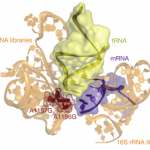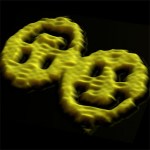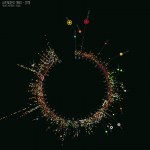Technology
Almost every living thing shares an identical genetic code, with three nucleic acids in an RNA sequence coding for a single amino acid in the translated protein sequence. While there are 64 three-letter RNA sequences, there are only 20 amino acids and degeneracy in the code allows some amino acids to be coded by multiple codons. Chemists and synthetic biologists in the past few years have been working to expand this genetic code, with unnatural nucleotides that can be incorporated into DNA and RNA sequences and unnatural amino acids that can expand the chemical functionality of proteins.…
The Genomes Environments Traits conference in Boston is without a doubt the place to be on April 27th for anyone interested in personal genomics: the conference has managed to attract nearly every human being in the world who has had their complete genome sequenced (excluding, of course, anonymous participants in the 1000 Genomes Project and various cancer studies), as well as an impressive list of luminaries from the field.
Wired describes the meeting as "The First and Last Meeting of Everyone with a Fully Sequenced Genome", and while that's a little hyperbolic (the…
Steve Fuller (and fuller) writes to ID creationist Bill Dembski's blog about the question Do We Need God To Do Science?:
I debated the question with the historian Thomas Dixon, who basically holds that while we may have needed God to do science, we donât need the deity anymore. My own view is that if we mean by âscienceâ something more than simply the pursuit of instrumental knowledge, then that quest still doesnât make much sense without the relevant (Abrahamic) theological backdrop. I continue this line of argument in a new book, due out this summer.
The question's answer is "no." This…
Increasingly, the cost of staying wired is eating up a huge part of people's budgets accordinging to The Times:
It used to be that a basic $25-a-month phone bill was your main telecommunications expense. But by 2004, the average American spent $770.95 annually on services like cable television, Internet connectivity and video games, according to data from the Census Bureau. By 2008, that number rose to $903, outstripping inflation. By the end of this year, it is expected to have grown to $997.07. Add another $1,000 or more for cellphone service and the average family is spending as much on…
The usual "This is the stuff that looks interesting to me" post, based on the preliminary online program. Subject to change if they move things around, or if I discover something I overlooked that sounds more interesting, or if I decide I'm hungry, and opt to blow off panels in favor of food.
This year's program is lighter on panels, but includes both a signing and a reading. Which will be a very different experience than years past...
Friday 7pm Harbor 1: The Singularity: An Appraisal
Arguably the idea of the Singularity -- a period where change happens so quickly that life afterwards is…
And now for something completely different.
I've been on a bit of a tear the last few days beating on Mike Adams, someone who arguably deserves the title of Woo--meister Supreme, but it's important to remember that defending science-based medicine is more than just having a little fun every now and then slapping down quacks. It's also about turning the same skeptical eyes that recognize the woo that people like Adams, Mercola, and the anti-vaccine movement promote onto scientific medicine when appropriate. That's because, at its best, science-based medicine is always trying to improve…
There are 27 new articles in PLoS ONE today. As always, you should rate the articles, post notes and comments and send trackbacks when you blog about the papers. You can now also easily place articles on various social services (CiteULike, Mendeley, Connotea, Stumbleupon, Facebook and Digg) with just one click. Here are my own picks for the week - you go and look for your own favourites:
Altruism in Forest Chimpanzees: The Case of Adoption:
In recent years, extended altruism towards unrelated group members has been proposed to be a unique characteristic of human societies. Support for this…
Last week's ScienceOnline2010, our fourth annual science communication conference in North Carolina, was our biggest, best and most successful event yet, and from the long list of blog and media coverage and the Flickr pictures, YouTube videos and Twitter mentions of the conference (all using the tag #scio10), it certainly seems the BlogTogether spirit was coursing through the 267 participants.
Anton and I can't be happier, or more proud, of what this conference achieved. More than anything, we are astounded by the openness with which so many people came together to share, explore, question,…
Last week's ScienceOnline2010, our fourth annual science communication conference in North Carolina, was our biggest, best and most successful event yet, and from the long list of blog and media coverage and the Flickr pictures, YouTube videos and Twitter mentions of the conference (all using the tag #scio10), it certainly seems the BlogTogether spirit was coursing through the 267 participants.
Anton and I can't be happier, or more proud, of what this conference achieved. More than anything, we are astounded by the openness with which so many people came together to share, explore, question,…
Our first 2010 American Scientist pizza lunch is scheduled for noon, Tuesday, Jan. 26. at Sigma Xi in Research Triangle Park. No doubt you've heard about the many forces degrading coastlines. This time we'll hear from someone intimately involved with the challenges of conserving and restoring North Carolina coastal ecosystems, especially oyster reefs. That would be David Eggelston, a marine biologist and director of the Center for Marine Science and Technology at N.C. State University.
American Scientist Pizza Lunch is free and open to science journalists and science communicators of all…
Disclaimer: my wife and I have both received and used free testing kits from Counsyl.
Counsyl is a rather enigmatic player in the personal genomics field: apart from a brief mention in Steven Pinker's excellent NY Times piece over a year ago and an even briefer post on a Newsweek blog late last year, the company has been in determined stealth mode for much of the last two years.
All that was publicly known about the company when I wrote about them last year was that they will be offering a large-scale carrier screening test: basically, allowing couples who are considering having a baby to…
Most synthetic biologists and biological engineers (and basically everyone else) think of DNA as code, simply carrying the information to make the RNA and proteins that do the real work inside the cell. In the past few years, a small group of biological engineers have used DNA instead as a physical substrate, a programmable nanomaterial to build all kinds of tiny shapes with (even smiley faces). The shapes that the DNA folds into depend on the sequence, which controls how different strands match up to each other and bend. For a great introduction to building shapes out of DNA in 2D and 3D…
I have managed to completely freak Zuska out, and for that, I can only offer both apologies and sympathy. It really sucketh deeply when people come bang up against the realities of depletion and climate change. And one of the things that so insidious about the painfulness of this encounter is that a lot of times, people who are ordinarily more critical in their responses, go to the worst possible scenarios with a kind of horrified fascination.
This is not totally unreasonable - not only is there tremendous social pressure to go to the apocalyptic (plenty of movies, lots of tv, fiction...)…
The big news from the JP Morgan investment conference today is the announcement of a brand new shiny sequencing machine from Illumina, the HiSeq 2000. The new machine boasts an impressive set of statistics, and looks likely to gradually replace Illumina's GAIIx as the workhorse of most modern sequencing facilities.
So, how excited should we be?
Let's be clear about this up front: this new machine, while impressive, represents an incremental advance rather than a dramatic technological leap forward. This is still second-generation sequencing, generating relatively small snippets of DNA…
When I was a post-doc, I spent a few months seriously thinking about changing careers and teaching high school. I might have followed through on that plan, too, but I didn't know how to pay for it.
Today, if you have a background in science, technology, math, or engineering, you can retrain to become a teacher and the National Science Foundation will help. The Robert Noyce scholarship program has funds to help ease that transition to the classroom.
From the NSF web site:
The Robert Noyce Teacher Scholarship Program seeks to encourage talented science, technology, engineering, and…
Next week, I'll be chairing a session at the Science Online 2010 conference called Rebooting science journalism in the age of the web. I'll be shooting the breeze with Carl Zimmer, John Timmer and David Dobbs about the transition of journalism from sheets of plant pulp to wires and wi-fi. The title of the talk had been set before the panel was assembled but, being biologists at heart, we're going to shift the metaphor from a technological one to an evolutionary one.
As a species, science journalists (in all their varied forms and behaviours) have found themselves thrust into a new digital…
For those who haven't read the Judge Dredd stories (I'm not referring to the movie), they take place in a dystopian future (other than Star Trek, do sci-fi stories occur in any other kind of future...) where the predominant theme is that, due to technological advances, very few people have jobs, creating huge urban megalopolises (megalopolae?) where crime is rampant.
With that cheery introduction, we note Matthew Yglesias' assessment of the news bidness:
You hear a lot of talk about different kinds of ideas to bolster revenue models or get people to read more. But the reality is that the web…
Note: If you've read all of this at the conference website and just want to pay,
CLICK HERE.
For those of you attending ScienceOnline2010, I'm the one tending to the Saturday night banquet at the headquarters hotel, The Radisson at Research Triangle Park.
The banquet will be held following the Saturday 16 January sessions beginning at 7 pm.
The dinner was a great success last year with about 135 of the registrants attending and was a great way to unwind and continue some of the discussions we began.
This year, the supper will be followed by the Ignite session. For those who don't know,…
I often get questions about bioinformatics, bioinformatics jobs and career paths. Most of the questions reflect a general sense of confusion between creating bioinformatics resources and using them. Bioinformatics is unique in this sense. No one confuses writing a package like Photoshop with being a photographer, yet for some odd reason, people seem to expect this of biologists. In the same respect, even the programmers and database administrators who work in bioinformatics, are unfairly assumed to have had graduate level training in biology.
In many ways, it's easiest to understand…
On Collective Imagination, Joe Salvo declares the Information Age is done for, writing: "a period of history can be characterized by the dominant technology that separates the leaders from the followers." He believes humanity has approached a tipping point where the separation between leaders and followers will cease to exist, as the internet democratizes the planet and good information becomes ubiquitous. So what's up next? Salvo calls it a "Systems Age," which involves "sensing, collecting, and manipulating data in near real-time with little to no human supervision." Sounds like a lot…



